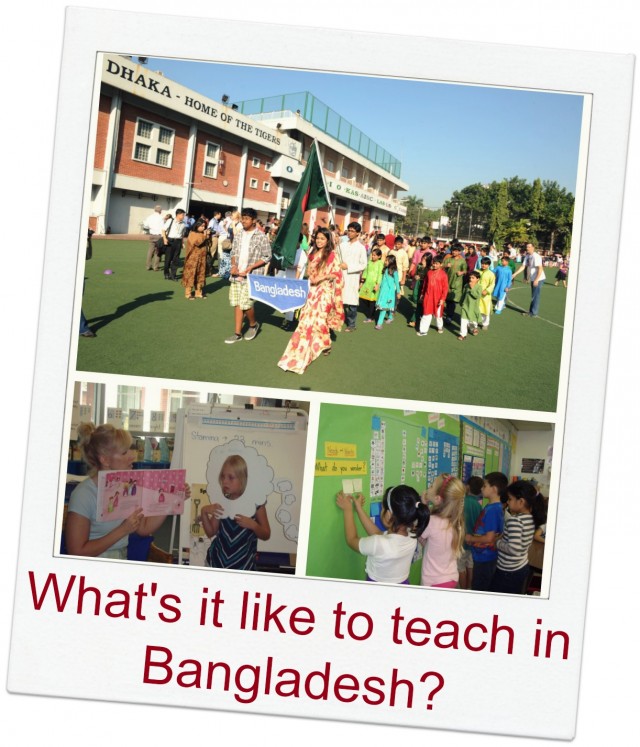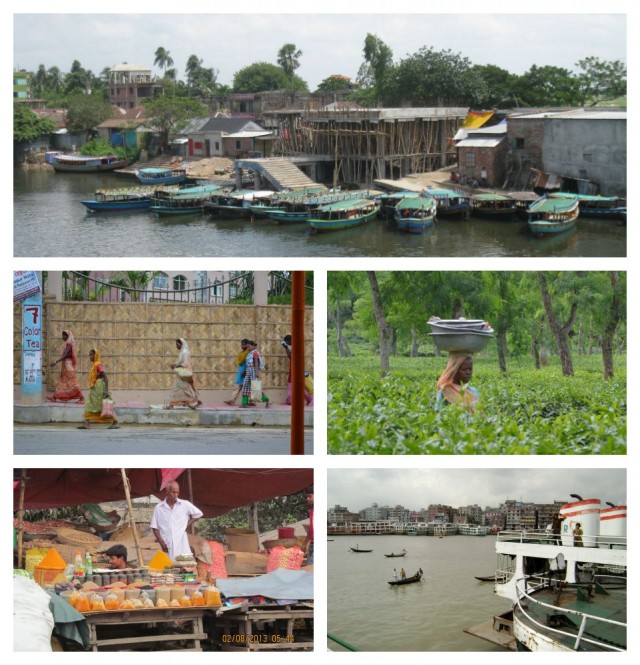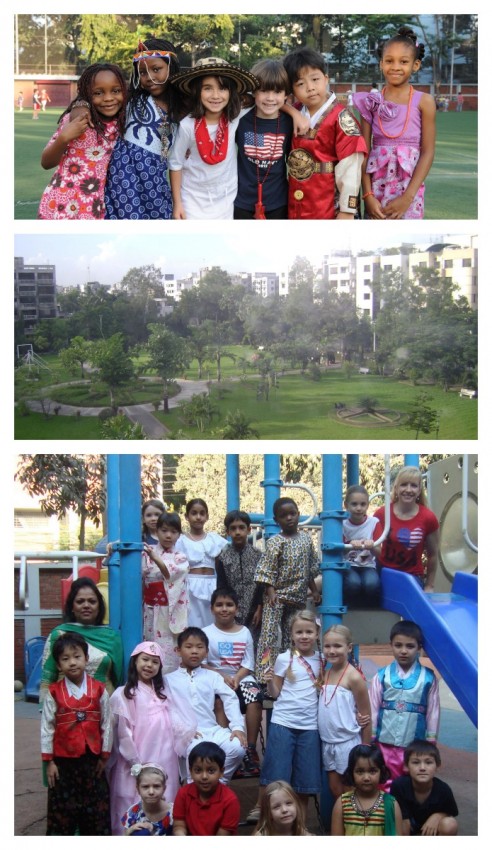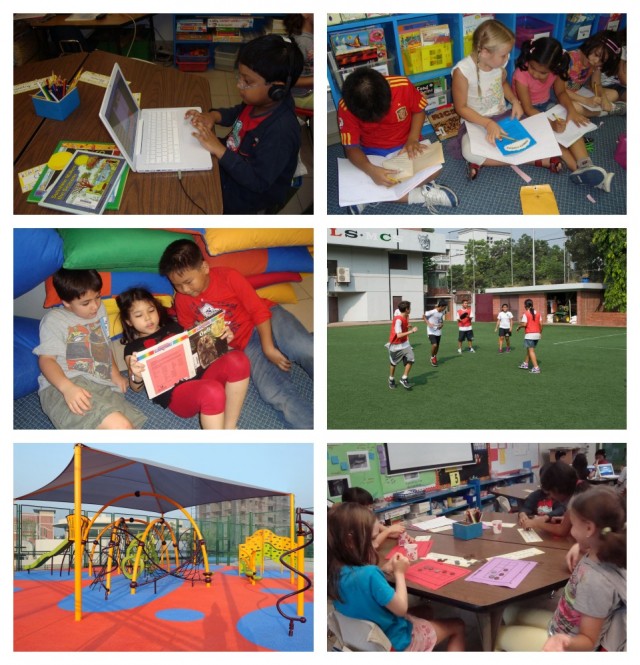
It’s been awhile since I’ve published a guest post in the Teaching Around the World blog series, and what better time than summer to daydream about seeing the world? In today’s post, we’ll hear from Karli Lomax, who has been a classroom teacher for 17 years. She’s originally from Massachusetts and earned her B.S. in Elementary Education from Boston University, then went on to teach PreK, kindergarten, and 3rd grade in Cambridge, MA, and Houston, TX, for 12 years collectively before moving overseas. Karli has spent the past 5 years teaching K and 1st grade at the American International School Dhaka, Bangladesh. She blogs at Creating a Thoughtful Classroom. Thank you, Karli, for sharing this with us!
How did you find yourself teaching in Bangladesh?
About 7 years ago, my husband and I were living “busy” lives. Both of us were teachers, but he also coached, served as the athletic director at his campus AND was a personal trainer on the side. We had two young children and two older children from his first marriage so it was always a balancing act. We were both also becoming quite discouraged by all of the testing pressures teachers faced. Having been in my district for ten years, I could see the downward trends. “The Test” had always been there, but it seemed like the education system was moving farther and farther away from best practice and what was in the best interest of children in order to make high test scores.
At the same time, through his job as a personal trainer my husband kept meeting people who had taught overseas and they told him all about the benefits, some being tax-free pay, free tuition for your own children, and of course the opportunity to travel the world. Since we were both pretty frustrated with so much focus being but on testing, we decided to look into the opportunity to teach abroad and discovered ISS, International School Services, an organization that helps teachers find jobs overseas. We applied with them and then went to a job fair in NYC, as is standard practice. It was similar to one I went to right out of college except that the administrators were from all around the world! Job fairs typically last a weekend, and during that time you try to make a match between your area of specialty and where you’d like to teach. Then you interview with as many principals as possible in hopes that you will be offered a position. That weekend was definitely a whirlwind, having to make such a big decision in a matter of days, but we ended up signing two-year contracts (standard for new hires) with the American International School Dhaka in Dhaka, Bangladesh because they had a good reputation for being a wonderful community school and a great place for families- and we have not been disappointed!

What is like to live in Bangladesh, in your experience?
Bangladesh is so completely different that the U.S.! It took me a good six months to adjust and begin to feel comfortable. Bangladesh is a developing country so a lot of things that we may take for granted as Americans are just not in place. For example, transportation is quite a challenge. We live in the capital city, Dhaka. It is a busy, crowded place with more than 15 million people that is plagued by traffic (as are most south Asian cities). It can take thirty minutes to an hour to travel a couple of miles!
Most people live in apartments, or flats. My school provides housing and vehicles for all teachers. My family and I enjoy a spacious 4 bedroom apartment that is located about 5 minutes form school- very convenient. Mot of what we need is close by, so we usually don’t battle the traffic often! I’m lucky enough that I can walk to school.
Shopping is very different in Bangladesh. We buy most food at outdoor markets, and main staples at a couple of general stores (definitely no big chains like Walmart or Target). This was a positive change for me as it made me realize how much packaged and processed food I had been eating! Since living in Bangladesh, I have learned to make quite a few things from scratch which my family really loves!
Clothes “shopping” is mostly done through tailors; women locally usually pick out their own fabrics and have their family tailor make all of their clothes. Western-style clothes can be hard to find pre-made. Even though Bangladesh is one of the biggest garment producers in the world, most of what is made is directly exported to retailers abroad. I personally find it easier to do most of my shopping at home in the States during the summer, and then I just bring it back to Dhaka!
I have found the people of Bangladesh to be friendly and kind. They are also incredibly creative and make lovely garments and handicrafts. It is a Muslim country in which most people respect others’ differences, and I have never felt unwanted or personally unsafe. As a Westerner, I’m often an interesting novelty- I’ve almost gotten used to the curious stares!

What are the biggest differences between schools where you live and American schools?
I was surprised to find out that Bangladeshis must pay for education because as an American I had taken the idea of public education for granted. Schools in Bangladesh depend on their tuition to run so the quality of education there varies greatly. Schools with more funds are also more well-resourced. From my understanding, teachers in local schools often teach in a lecture style requiring students to listen to and memorize what’s being taught. Great importance is placed on end-of-term exams. Exam scores and class rank determine whether or not a student is successful.Unfortunately, there are many, many children that cannot go to school simply because their family is too poor to send them. On a positive note, there are organizations as well as individuals at work in Bangladesh trying to do what they can to give children and people access to an education.
My school is a private international school that serves the international community and it is very different than local schools. My school is very similar to what you would find across the U.S., however, it also more globally minded, and inquiry-based.
Tell us the basics about your job. How many students do you have? How long is your school day? What subjects do you teach?
I love my job because I love my school! Many people would be surprised to find out that my job as a first grade teacher is very much like that of any teacher in America as it is based on American educational principles. The instructional language is English and we follow a standards-based curriculum (like many U.S. states) while also implementing the Primary Years Programme (PYP) framework which is centered on inquiry-based learning and teaching conceptually.
This past year I had twenty students in my first grade class from fourteen different countries! Many students are ELLs at various levels, however, this was also the case for me when I taught in the States. Our school day starts at 7:45 and ends at 2:40, and we go to school from Sunday to Thursday as Friday is the Muslim holy day in Bangladesh. Yes, this is quite different and takes a while to get used too, but I still get a weekend- it’s just different days!
I teach all subjects and students go to specialists for Library, Art, Performing Arts/Music, PE and Host Country Studies (HCS). HCS is always part of PYP international schools so that students can learn about and gain appreciation for the country in which they’re currently living. On an average day I start with calendar math and morning meeting. After a morning snack recess, we have a long literacy block which includes reading and writing workshops that goes until lunch. During the afternoon I typically teach math workshop and the unit of inquiry (PYP) which is based on science or social studies concepts. We end the day with read aloud and closing circle.
What’s the best part about your teaching experience in Bangladesh?

The best part about my teaching experience in Bangladesh is the growth I’ve experienced through being introduced to different teaching methods from around the world, as well as people and students from all around the world. I have experienced a great deal of support from my administration to pursue my teaching passions through professional development. Most international schools offer professional development stipends which allow to continue to grow in your knowledge of best teaching practices.
Living overseas and traveling to other countries during school breaks has allowed me to consider other perspectives and grow personally in ways that may never had happened if I had stayed in the States. It’s hard to express how valuable this opportunity has been.
What’s the toughest part?
The toughest part about teaching in Bangladesh is also a positive; because the school is the center of the community, there are always functions and activities going on, and this can lead to a very busy schedule! Due to the smaller nature of most international schools, teachers are more often called upon to serve in other roles, like coaching, leading after school activities or participating in social events. My family and I strive to maintain a balance between home and school, but it can be really difficult!
The toughest part about living in Bangladesh for me personally is dealing with life’s little inconveniences like traffic, or not having so many things accessible whenever I want them (foods, clothes, home & school supplies!) At times it feels frustrating, but I have also learned that I don’t always need “stuff” to be happy, OR to be a good teacher! I’ve learned to be even more grateful for who I am as an American, what I have, and to find the joy and peace that can come from the simple things in life!
What advice would you give teachers who would like to teach in Bangladesh? Are the school systems looking to hire teachers internationally?
I would tell any teacher who is interested in working overseas to go for it, especially if you are single! You will have amazingly enriching experiences, and if you don’t feel that it’s right for you, you can return home after your contract. There are hundreds of wonderful schools out there with adventures to be had and memories waiting to be made!

You can read more teaching around the world blog posts from this series and see what it’s like to be a teacher in different places. If you have questions for Karli about teaching in Bangladesh, please ask in the comment section below. Or, if you teach in an unusual place and would like to be featured in this space, send me an email. I would love to share your story!

Angela Watson
Founder and Writer
Sign up to get new Truth for Teachers articles in your inbox
Discussion
OR

Join our
community
of educators
If you are a teacher who is interested in contributing to the Truth for Teachers website, please click here for more information.
















Hi,
I absolutely loved reading your blog and I am interested in teaching in Bangladesh. I wanted to ask you what the salary for teaching in Bangladesh is.
Can you tell me about the recesses in Bangladesh’s schools?
Can you tell me about the recesses in Bangladesh? Could you also explain where people meet to go to school?
I am a single parent with 8 year old son. How safe is working in Dhaka? I have many years experience teaching in uk – what kind of salary can i expect?